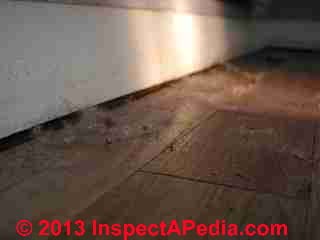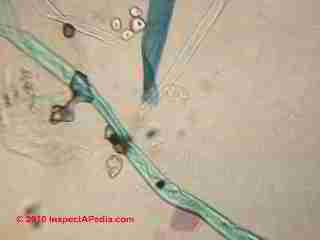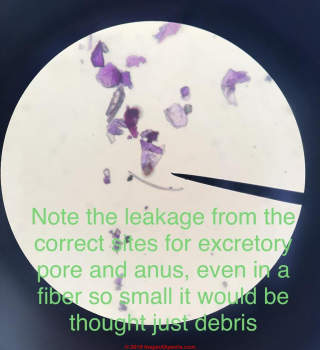 House Dust Composition FAQs
House Dust Composition FAQs
Q&A on what's in house or building dust
- POST a QUESTION or COMMENT about fiberglass dust particle identification procedures & testing
Questions & answers on the composition of house dust or building dust:
This article series describes the common as well as less-common constituents of house dust and typical office building dust.
InspectAPedia tolerates no conflicts of interest. We have no relationship with advertisers, products, or services discussed at this website.
- Daniel Friedman, Publisher/Editor/Author - See WHO ARE WE?
Q&A on Contents of House Dust & Office Building Dust
 These questions & answers about what's in building dust, building dust characterization, analysis, hazards, and management, were posted originally at x - be sure to review that information.
These questions & answers about what's in building dust, building dust characterization, analysis, hazards, and management, were posted originally at x - be sure to review that information.
Usually the dominant constituents of house dust (fabric fibers, skin cells) do not pose a health hazard to humans.
Some building or house dust may include dust particles that carry potentially harmful carcinogens, endocrine disruptors, or that cause other illnesses or disorders.
Question: how to proceed in solving a bothersome indoor air quality and dust problem
2/19/2014 Karen said:
I found all of your articles to be very professional, forthright, and informative. I have been experiencing some air quality problems in my home.
To the extent that I have developed a severe allergic reaction every time the heat or air condition is on. We had a mold inspection and testing done and the results were negative. Although this was good news the problem persists. I've also discovered black soot on the glass surfaces, an unusually extreme amount of black fiber like particles on surfaces, along with a cottony like dust on services as well.
In addition, the filters in the air condition/heating unit gets very dirty with a dark gray / black substance within a weeks time. Theses are the high grade expensive type filters that should last for a minimum of 90 days. I am at my wits end and don't know what to do next!
We also had the air ducts cleaned to try to rectify the problem but this also did not resolve the issues. I purchased an air purifier which collects the black particle and dust on a daily bases. The particles have also settled on our clothing in the closets.
Finally, there is black soot like substance on the carpet edges against the walls in the bedrooms. The rest of the house has hardwood floors. I'm suspecting that it could be fiberglass particles being released through the HVAC systems and/or the insulation has been infiltrated by mold. - K. 2/19/2014
Reply:
Karen, thanks for the nice comment about our website: we work hard to provide authoritative and unbiased information so I'm always thrilled when someone reports finding our work useful.
Now to the question: without more information about the building, its condition, history, occupant complaints, and absent a smoking gun observation of a significant mold contamination problem, and without an observation of mold odors, I would not start by assuming we are looking at a mold problem.
I would take a careful look at the building and its mechanical systems and at occupant complaints, focused on identifying the highest risk areas that may justify further testing or even invasive inspection if that's appropriate. MOLD / ENVIRONMENTAL EXPERT, HIRE ? has some advice about how we decide if hiring an expert is appropriate compared with a DIY approach or using building cleaning or maintenance contractors or a home inspector to take a look for you.
1. I would not assume that a mold "test" alone would be reliable - with all test methods there is a high risk of false negative results; if your "mold inspection" was by someone who understands buildings, where leaks and water go, where mold grows, etc. that would be most helpful.
2. The HVAC system could have a mold or other respiratory irritant reservoir in the air handler or duct system, but it can also simply be moving air from one building are to another, moving irritants in the process. Pay particular attention to where return air is being picked up.
3. Without more data I would not assume the issue is mold, though if you say the building history includes leak or moisture traps that'd be a reasonable concern.
4. The debris depositing you describe can be easily tested (see our DIY house dust test kit procedure using adhesive tape) and with a competent environmental lab should be inexpensive - sometimes the dust or debris contains something unusual that points to a problem source.
5. Black stains around carpet edges suggests air leakage to me - suggesting air moving up from the space below. If your hone includes a crawl space that's an area deserving careful inspection.
6. Air purifiers: regarding your lack of success trying to address these concerns with a portable air purifier, IMO there is no portable air purifier or more accurately air cleaning machine on the market, nor has there been, nor is there likely to be, that is capable of removing an IAQ problem source in a building any more than you could vacuum dust bunnies from under the living room couch by waving a vacuum cleaner wand in the air in the kitchen.
Perhaps in a small, enclosed space that does not itself contain the problem reservoir a portable air filtration device or well-designed central air handling system filtration can reduce the airborne particle level but that's not going to correct the underlying problem.
On 2019-05-16 by (mod) - where to buy house dust for lab purposes
Re-posting from private email:
Would you have information regarding where I could purchase household dust for use in lab testing?
Sandra Villarreal EMAIL: SAVillar@scj.com
Moderator reply:
For the purpose of studying house dust one would perhaps want to know the characteristics of the building where the dust was collected, country, city, age, leak, mold and other conditions, building materials, occupants, presence or absence of pets or other animals, number of occupants, medical conditions, furnishings, etc.
For purposes of using house dust to calibrate forensic equipment one might want to know the consistency of the dust across a sample of given volume.
Household dust is ubiquitous and free and easily collected by tape samples, sweeping, or vacuuming,.
Therefore I think you'd need to define your lab testing requirements more explicitly for us to suggest a different answer than don't buy house dust, "it's free" and "it's everywhere".
On 2019-04-02 by (mod) - nematodes in house dust? nematodes in human tissues?
 Thanks Lindy that's very interesting.
Thanks Lindy that's very interesting.
What would be most-helpful to add would be a description of the vector of movement of nematodes from environment into humans.
I have not focused on nematodes in environmental samples but it's certainly a credible possibility even in soil dust that can thus show up in both outdoor air and indoor air samples in some situations.
- Wall, Diana H., Uffe N. Nielsen, and Johan Six. "Soil biodiversity and human health." Nature 528, no. 7580 (2015): 69.
- Darby, Brian J., Deborah A. Neher, and Jayne Belnap. "Soil nematode communities are ecologically more mature beneath late-than early-successional stage biological soil crusts." Applied Soil Ecology 35, no. 1 (2007): 203-212.
- Pullen, Erroll M. "Fluid, formulation, and method for dust control and dewatering of particulate materials." U.S. Patent 5,958,287, issued September 28, 1999.
- Ferris, Howard, Hideomi Minoshima, Sara Sánchez-Moreno, and Louise Jackson. "Linking soil properties and nematode community composition: effects of soil management on soil food webs." Nematology 8, no. 5 (2006): 703-715.
On 2019-03-14 by Lindy
Have you come across nematodes in your observations? I have a DVM degree, and taught histology to undergraduate biology students in the past. Currently researching what I think is a novel nematode infection in mammals.
I found it first in my patients tissues, but in an attempt to characterize the lifecycle of this putative novel pathogen, realized it must have a phase of the lifecycle in the environment.
I’ve been examining dust samples from the owners home and feel that I am seeing numerous egg-case like objects as well as nematode-like structures ranging from L-1 larvae to adults.
I’ve seen nothing published to suggest a president for anything like this in dry environments. Have you come across anything like this? Stains include fushin red, neutral red, crystal violet, as well as H&E.
It is difficult to demonstrate all of the characteristics of what I am seeing without examining multiple images, but I’ve attached one that shows some features of a potential very immature nematode larvae, as well as some of the background debris. This one stained with acid fushin.
...
Continue reading at HOUSE DUST COMPONENTS - topic home, or select a topic from the closely-related articles below, or see the complete ARTICLE INDEX.
Or see these
Articles on building dust or house dust
- HOUSE DUST ANALYSIS
- AIRBORNE PARTICLE ANALYSIS METHODS
- ALLERGENS in BUILDINGS
- CARPET DUST IDENTIFICATION
- AIRBORNE PARTICLE COUNT VARIATION CAUSES
- AIRBORNE PARTICLE COUNT VARIATION EXTENT
- CONCRETE DUST & ODORS
- DUST ANALYSIS for FIBERGLASS
- DUST, HVAC CONTAMINATION STUDY
- DUST SAMPLE TYPES we distinguish between "old house dust" and "recent house dust" which in turn can aid in building indoor air quality investigation diagnosis
- DUST SAMPLING PROCEDURE
- TEST KIT for DUST, MOLD, PARTICLES: INSTRUCTIONS
- FIBER & HAIR IDENTIFICATION
- FIBERGLASS AIR DUCT MOLD TEST
- FIBERGLASS PARTICLE CONTAMINATION TEST
- HOUSE DUST CHEMICAL CONTAMINANTS
- HOUSE DUST COMPONENTS
- HOUSE DUST PARTICLE PHOTOS - a photo tour of what we found in dust from a London loft.
- HVAC DUST CONTAMINATION STUDY - what do we find in dust in a heating or air conditioning system?
- AIRBORNE PARTICLE COUNTS in DUCTWORK
- AIRBORNE PARTICLE COUNTS vs SAMPLER HEIGHT
- AIRBORNE PARTICLE COUNTS vs WINDOWS, DOORS
- AIRBORNE PARTICLE & MOLD LEVELS in DUCTWORK
- USES of AIRBORNE PARTICLE SAMPLING
Suggested citation for this web page
HOUSE DUST COMPONENT FAQs at InspectApedia.com - online encyclopedia of building & environmental inspection, testing, diagnosis, repair, & problem prevention advice.
Or see this
INDEX to RELATED ARTICLES: ARTICLE INDEX to BUILDING FORENSICS
Or use the SEARCH BOX found below to Ask a Question or Search InspectApedia
Or see
INDEX to RELATED ARTICLES: ARTICLE INDEX to BUILDING ENVIRONMENT
Or use the SEARCH BOX found below to Ask a Question or Search InspectApedia
Or see
INDEX to RELATED ARTICLES: ARTICLE INDEX to BUILDING INDOOR AIR QUALITY IAQ
Or use the SEARCH BOX found below to Ask a Question or Search InspectApedia
Ask a Question or Search InspectApedia
Try the search box just below, or if you prefer, post a question or comment in the Comments box below and we will respond promptly.
Search the InspectApedia website
Note: appearance of your Comment below may be delayed: if your comment contains an image, photograph, web link, or text that looks to the software as if it might be a web link, your posting will appear after it has been approved by a moderator. Apologies for the delay.
Only one image can be added per comment but you can post as many comments, and therefore images, as you like.
You will not receive a notification when a response to your question has been posted.
Please bookmark this page to make it easy for you to check back for our response.
IF above you see "Comment Form is loading comments..." then COMMENT BOX - countable.ca / bawkbox.com IS NOT WORKING.
In any case you are welcome to send an email directly to us at InspectApedia.com at editor@inspectApedia.com
We'll reply to you directly. Please help us help you by noting, in your email, the URL of the InspectApedia page where you wanted to comment.
Citations & References
In addition to any citations in the article above, a full list is available on request.
- Horak, B. "Preliminary study on the concentration and species composition of bacteria, fungi and mites in samples of house dust from Silesia (Poland)." Allergologia et immunopathologia 15, no. 3 (1987): 161.
- Fergusson, Jack E., Eric A. Forbes, Robyn J. Schroeder, and Douglas E. Ryan. "The elemental composition and sources of house dust and street dust." Science of the total environment 50 (1986): 217-221.
Abstract: The elemental compositions of house dust, street dust and soil have been determined for 26 elements on material collected in Christchurch, New Zealand. The elements Hf, Th, Sc, Sm, Ce, La, Mn, Na, K, V, Al and Fe may be considered to be soil-based and contribute about 45–50% to house dust and 87% to street dust. The elements which are enriched (>3 times) in the dusts relative to the levels found in local soils, are Br, Cu, Cl, Pb, Zn, Cr, Ca, Co, As and Sb in house dust, and Zn, Cr, Cu and Pb in street dust. - Mølhave, L., T. Schneider, S. K. Kjaergaard, L. Larsen, Svend Norn, and O. Jørgensen. "House dust in seven Danish offices." Atmospheric Environment 34, no. 28 (2000): 4767-4779.
- Butte, Werner, and Birger Heinzow. "Pollutants in house dust as indicators of indoor contamination." Reviews of environmental contamination and toxicology 175 (2002): 1-46.
- Post, S., M. C. Nawijn, T. L. Hackett, M. Baranowska, R. Gras, A. J. M. van Oosterhout, and I. H. Heijink. "The composition of house dust mite is critical for mucosal barrier dysfunction and allergic sensitisation." Thorax 67, no. 6 (2012): 488-495.
- Stapleton, Heather M., Nathan G. Dodder, John H. Offenberg, Michele M. Schantz, and Stephen A. Wise. "Polybrominated diphenyl ethers in house dust and clothes dryer lint." Environmental science & technology 39, no. 4 (2005): 925-931.
- Colt, Joanne S. "Comparison of pesticides and other compounds in carpet dust samples collected from used vacuum cleaner bags and from a high-volume surface sampler." Environmental health perspectives 106, no. 11 (1998): 721.
- Dybendal, T., W. C. Wedberg, and S. Elsayed. "Dust from carpeted and smooth floors: IV. Solid material, proteins and allergens collected in the different filter stages of vacuum cleaners after ten days of use in schools." Allergy 46, no. 6 (1991): 427-435.
- Korpi, A., A-L. Pasanen, P. Pasanen, and P. Kalliokoski. "Microbial growth and metabolism in house dust." International biodeterioration & biodegradation 40, no. 1 (1997): 19-27.
- Lewis, Robert G., Christopher R. Fortune, Robert D. Willis, David E. Camann, and Jeffrey T. Antley. "Distribution of pesticides and polycyclic aromatic hydrocarbons in house dust as a function of particle size." Environmental health perspectives 107, no. 9 (1999): 721.
- Lioy, Paul J., Thomas Wainman, Junfeng Zhang, and Susan Goldsmith. "Typical household vacuum cleaners: the collection efficiency and emissions characteristics for fine particles." Journal of the Air & Waste Management Association 49, no. 2 (1999): 200-206
- Luczynska, Christina M., Yin Li, Martin D. Chapman, and Thomas AE Platts-Mills. "Airborne concentrations and particle size distribution of allergen derived from domestic cats (Felis domesticus)." Am Rev Respir Dis 141, no. 361 (1990): 7.
- Maertens, Rebecca M., Jennifer Bailey, and Paul A. White. "The mutagenic hazards of settled house dust: a review." Mutation Research/Reviews in Mutation Research 567, no. 2 (2004): 401-425.
- Marklund, Anneli, Barbro Andersson, and Peter Haglund. "Screening of organophosphorus compounds and their distribution in various indoor environments." Chemosphere 53, no. 9 (2003): 1137-1146.
- Miller, J. D., A. M. Laflamme, Y. Sobol, P. Lafontaine, and R. Greenhalgh. "Fungi and fungal products in some Canadian houses." International Biodeterioration 24, no. 2 (1988): 103-120.
- Moriwaki, Hiroshi, Yumiko Takata, and Ryuichi Arakawa. "Concentrations of perfluorooctane sulfonate (PFOS) and perfluorooctanoic acid (PFOA) in vacuum cleaner dust collected in Japanese homes." Journal of Environmental Monitoring 5, no. 5 (2003): 753-757.
- Woodfolk, Judith A., Christina M. Luczynska, Frederic de Blay, Martin D. Chapman, and Thomas AE Platts-Mills. "The effect of vacuum cleaners on the concentration and particle size distribution of airborne cat allergen." Journal of allergy and clinical immunology 91, no. 4 (1993): 829-837.
- Our recommended books about building & mechanical systems design, inspection, problem diagnosis, and repair, and about indoor environment and IAQ testing, diagnosis, and cleanup are at the InspectAPedia Bookstore. Also see our Book Reviews - InspectAPedia.
- In addition to citations & references found in this article, see the research citations given at the end of the related articles found at our suggested
CONTINUE READING or RECOMMENDED ARTICLES.
- Carson, Dunlop & Associates Ltd., 120 Carlton Street Suite 407, Toronto ON M5A 4K2. Tel: (416) 964-9415 1-800-268-7070 Email: info@carsondunlop.com. Alan Carson is a past president of ASHI, the American Society of Home Inspectors.
Thanks to Alan Carson and Bob Dunlop, for permission for InspectAPedia to use text excerpts from The HOME REFERENCE BOOK - the Encyclopedia of Homes and to use illustrations from The ILLUSTRATED HOME .
Carson Dunlop Associates provides extensive home inspection education and report writing material. In gratitude we provide links to tsome Carson Dunlop Associates products and services.

